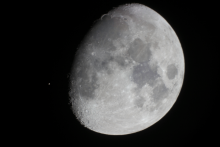Listen to today's episode of StarDate on the web the same day it airs in high-quality streaming audio without any extra ads or announcements. Choose a $8 one-month pass, or listen every day for a year for just $30.
You are here
Moon and Aldebaran
It’s not easy to measure the “weight” of a star that moves through space alone. You can’t just put it on a scale. Instead, astronomers try to determine its mass by measuring its temperature, its composition, how fast it spins, and more. And even then, they can change their minds as new observations become available. That applies even to some of the most intensely studied stars of all.
One example is Aldebaran, which marks the eye of Taurus, the bull. It appears near the Moon late tonight.
Aldebaran is one of the brightest stars in the night sky, so astronomers have been studying it for centuries. Until the last couple of years, most of their studies put its mass at about 1.7 times the mass of the Sun. But in 2018, a team of astronomers reported a new number: 1.16 times the mass of the Sun.
The team was studying a planet that orbits Aldebaran. The planet was discovered by measuring its gravitational pull on the star. The newer study measured not only that, but vibrations on the surface of Aldebaran. The vibrations are caused by sound waves that bounce around inside the star. The way they move can reveal the star’s mass.
If the newer mass is correct, it’s good news for life in the system. It means that Aldebaran would have been cooler and lived much longer than thought. So conditions on any moons around the heavy planet could have been fairly comfortable for a long time — giving life a chance to take hold.




